
The growing interest in unmanned systems for use by Indian police and law enforcement agencies is bringing the Home Ministry to evaluate some of the technologies available for paramilitary use. Indian police forces are expressing interest in deploying mini and micro UAVs for years, and some have embarked on experimental evaluation programs, but only recently the interest was translated into action, with the procurement of the first two system by the Chandigarh Police.


Netra, a vertically take of and landing UAV that unlike the Golden Hawk, can also hover, was developed by DRDO Research and Development Establishment (RnDE) lab. Netra can send live video or thermal imaging via wireless link, to the operator system located several kilometers away. The system was recently tested in Chatisgarh to evaluate its utility to fight Naxal insurgency in these areas. The use of such lightweight hovering platforms seems to better conform with police uses, since its localized, low-level operational envelope better conforms with air traffic limitations.
The private sector in India is embracing the opportunity, offering indigenously developed or imported systems addressing the new police requirements. Following Chandigarh, another unit at Haryana has expressed interest in the mini-drones, inviting the Bangalore-based Israeli company BlueBird Aerosystems to demonstrate its MicroB, which has been in use by Israel’s security forces for several years. Another domestic company specializing in civil applications of small UAVs is Aurora Integrated Systems (AIS), vertically integrated specialist company offering UAS and aerostat based aerial sensors.
Swallow Systems is small company that also specializes in small unmanned systems. At Aero India 2011 Swallow Systems introduced the Skimmer UAS, a 2.5 kg portable, hand launched, battery operated UAV that looks as a copy of the U.S. Raven but, according to the manufacturer, offers much improved performance and reliability. The company offers the Swallow for military, paramilitary and civil applications, including aerial reconnaissance with recordable live video down feed in the events of forest fires, natural calamities and for wildlife monitoring, area mapping, and perimeter surveillance.
Elsewhere, police forces in the U.S. and the U.K. have already been using micro drones for several years, but the level of usage is limited by restrictions imposed by conflicting air traffic regulations banning unmanned vehicles operations in civil airspace. For example, in Texas, Special Weapons and Tactics (SWAT) teams were using the Aerovironment Wasp drone, originally developed for the U.S. Special Operations and Marine Corps while the Miami Police has tested the Honeywell T-Hawk since 2008.
The wide use of drones has been limited due to the potential risk they pose to flying activity. In the U.S. police units planning to operate UAVs must file request for permission for such activity with the Federal Aviation Administration (FAA), which controls the national airspace. By 2013, the FAA expects to have formulated new rules that would allow police across the country to routinely fly lightweight, unarmed drones up to 400 feet (122 m’) above the ground – high enough for them to be largely invisible eyes in the sky.
















